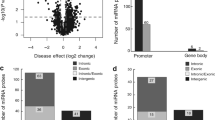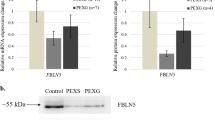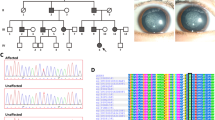Abstract
This study is intended to investigate the epigenetic regulation of the most conserved molecular chaperone, HSP70 and its potential role in the pathophysiology of pseudoexfoliation syndrome (PEXS) and glaucoma (PEXG), a protein aggregopathy, contributing significantly to world blindness. Expression levels of HSP70 were significantly decreased in the lens capsule (LC) of PEXS but not in PEXG compared with that in control. Bisulfite sequencing of the LC of the study subjects revealed that the CpG islands (CGIs) located in the exonic region but not in the promoter region of HSP70 displayed hypermethylation only in PEXS individuals. There was a corresponding increase in DNA methyltransferase 3A (DNMT3A) expression in only PEXS individuals suggesting de novo methylation in this stage of the disease condition. On the other hand, peripheral blood of both PEXS and PEXG cases showed hypermethylation in the exonic region when compared with non-PEX controls displaying tissue-specific effects. Further, functional analyses of CGI spanning the exon revealed a decreased gene expression in the presence of methylated in comparison with unmethylated reporter gene vectors. Treatment of human lens epithelial B-3 (HLE B-3) cells with DNMT inhibitor restored the expression of HSP70 following depletion in methylation level at exonic CpG sites. In conclusion, a decreased HSP70 expression correlates with hypermethylation of a CGI of HSP70 in PEXS individuals. The present findings enhance our current understanding of the mechanism underlying HSP70 repression, contributing to the pathogenesis of PEX.
This is a preview of subscription content, access via your institution
Access options
Subscribe to this journal
Receive 12 print issues and online access
$259.00 per year
only $21.58 per issue
Buy this article
- Purchase on Springer Link
- Instant access to full article PDF
Prices may be subject to local taxes which are calculated during checkout







Similar content being viewed by others
References
Ritch R, Schlötzer-Schrehardt U. Exfoliation syndrome. Surv Ophthalmol. 2001;45:265–315.
Ritch R. Exfoliation syndrome and occludable angles. Trans Am Ophthalmol Soc. 1994;92:845–944.
Heijl A, Bengtsson B, Hyman L, Leske MC. Natural history of open-angle glaucoma. Ophthalmology. 2009;116:2271–6.
Schlotzer-Schrehardt U, Naumann GOH. Trabecular meshwork in pseudoexfoliation syndrome with and without open-angle glaucoma: a morphometric, ultrastructural study. Investig Ophthalmol Vis Sci. 1995;36:1750–64.
Ehrlich R, Harris A, Lopez CR, Kheradiya NS. Pseudoexfoliation and blood flow abnormalities. Curr J Glaucoma Pract. 2008;2:18–25.
Takai Y, Tanito M, Ohira A. Multiplex cytokine analysis of aqueous humor in eyes with primary open-angle glaucoma, exfoliation glaucoma, and cataract. Investig Ophthalmol Vis Sci. 2012;53:241–7.
Helbig H, Schlötzer-Schrehardt U, Noske W, Kellner U, Foerster MH, Naumann GO. Anterior-chamber hypoxia and iris vasculopathy in pseudoexfoliation syndrome. Ger J Ophthalmol. 1994;3:148–53.
Tanito M, Kaidzu S, Takai Y, Ohira A. Status of systemic oxidative stresses in patients with primary open-angle glaucoma and pseudoexfoliation syndrome. PLoS ONE. 2012;7:1–7.
Hayat B, Padhy B, Mohanty PP, Alone DP. Altered unfolded protein response and proteasome impairment in pseudoexfoliation pathogenesis. Exp Eye Res. 2019;181:197–207.
Schlötzer-Schrehardt U, Naumann GOH. Ocular and systemic pseudoexfoliation syndrome. Am J Ophthalmol. 2006;141:921–37.
Zenkel M, Pöscbl E, Von Der Mark K, Hofmann-Rummelt C, Naumann GOH, Kruse FE, et al. Differential gene expression in pseudoexfoliation syndrome. Investig Ophthalmol Vis Sci. 2005;46:3742–52.
Zenkel M, Kruse FE, Naumann GOH, Schlötzer-Schrehardt U. Impaired cytoprotective mechanisms in eyes with pseudoexfoliation syndrome/glaucoma. Investig Ophthalmol Vis Sci. 2007;48:5558–66.
Bock C, Lengauer T. Computational epigenetics. Bioinformatics. 2008;24:1–10.
Mathelier A, Fornes O, Arenillas DJ, Chen CY, Denay G, Lee J, et al. JASPAR 2016: a major expansion and update of the open-access database of transcription factor binding profiles. Nucleic Acids Res. 2016;44:D110–5.
Gardiner-Garden M, Frommer M. CpG Islands in vertebrate genomes. J Mol Biol. 1987;196:261–82.
Goll MG, Bestor TH. Eukaryotic cytosine methyltransferases. Annu Rev Biochem. 2005;74:481–514.
Padhy B, Nanda GG, Chowdhury M, Padhi D, Rao A, Alone DP. Role of an extracellular chaperone, clusterin in the pathogenesis of pseudoexfoliation syndrome and pseudoexfoliation glaucoma. Exp Eye Res. 2014;127:69–76.
Padhy B, Hayat B, Nanda GG, Mohanty PP, Alone DP. Pseudoexfoliation and Alzheimer’s associated CLU risk variant, rs2279590, lies within an enhancer element and regulates CLU, EPHX2 and PTK2B gene expression. Hum Mol Genet. 2017;26:4519–29.
Ryan MT, Pfanner N. Hsp70 proteins in protein translocation. Adv Protein Chem. 2001;59:223–42.
Hartl FU, Bracher A, Hayer-Hartl M. Molecular chaperones in protein folding and proteostasis. Nature. 2011;475:324–32.
Mathur SK, Sistonen L, Brown IR, Murphy SP, Sarge KD, Morimoto RI. Deficient induction of human hsp70 heat shock gene transcription in Y79 retinoblastoma cells despite activation of heat shock factor 1. Proc Natl Acad Sci USA. 1994;91:8695–9.
Deaton AM, Bird A. CpG islands and the regulation of transcription. Genes Dev. 2011;25:1010–22.
Illingworth R, Kerr A, DeSousa D, Jørgensen H, Ellis P, Stalker J, et al. A novel CpG island set identifies tissue-specific methylation at developmental gene loci. PLoS Biol. 2008;6:37–51.
Zhou P, Luo Y, Liu X, Fan L, Lu Y. Down-regulation and CpG island hypermethylation of CRYAA in age-related nuclear cataract. FASEB J. 2012;26:4897–902.
Palsamy P, Ayaki M, Elanchezhian R, Shinohara T. Promoter demethylation of Keap1 gene in human diabetic cataractous lenses. Biochem Biophys Res Commun. 2012;423:542–8.
Ye H, Jiang Y, Jing Q, Li D, Maimaiti T, Kasimu D, et al. LOXL1 hypermethylation in pseudoexfoliation syndrome in the uighur population. Investig Ophthalmol Vis Sci. 2015;56:5838–43.
Okano M, Bell DW, Haber DA, Li E. DNA methyltransferases Dnmt3a and Dnmt3b are essential for de novo methylation and mammalian development. Cell. 1999;99:247–57.
Venugopal R, Jaiswal AK. Nrf2 and Nrf1 in association with Jun proteins regulate antioxidant response element-mediated expression and coordinated induction of genes encoding detoxifying enzymes. Oncogene. 1998;17:3145–56.
Izumi H, Ohta R, Nagatani G, Ise T, Nakayama Y, Nomoto M, et al. p300/CBP-associated factor (P/CAF) interacts with nuclear respiratory factor-1 to regulate the UDP-N-acetyl-α-D-galactosamine: polypeptide N-acetylgalactosaminyltransferase-3 gene. Biochem J. 2003;373:713–22.
Gui Y, Guo G, Huang Y, Hu X, Tang A, Gao S, et al. Frequent mutations of chromatin remodeling genes in transitional cell carcinoma of the bladder. Nat Genet. 2011;43:875–8.
Zhang Z. Phosphorylation of Kruppel-like factor 5 (KLF5/IKLF) at the CBP interaction region enhances its transactivation function. Nucleic Acids Res. 2003;31:2196–208.
Wang GL, Semenza GL. General involvement of hypoxia-inducible factor 1 in transcriptional response to hypoxia. Proc Natl Acad Sci USA. 1993;90:4304–8.
Laurenzana A, Petruccelli LA, Pettersson F, Figueroa ME, Melnick A, Baldwin AS, et al. Inhibition of DNA methyltransferase activates tumor necrosis factor A-induced monocytic differentiation in acute myeloid leukemia cells. Cancer Res. 2009;69:55–64.
Tabolacci E, Mancano G, Lanni S, Palumbo F, Goracci M, Ferrè F, et al. Genome-wide methylation analysis demonstrates that 5-aza-2-deoxycytidine treatment does not cause random DNA demethylation in fragile X syndrome cells. Epigenetics Chromatin. 2016;9:12. http://epigeneticsandchromatin.biomedcentral.com/articles/10.1186/s13072-016-0060-x.
Juttermann R, Li E, Jaenisch R. Toxicity of 5-aza-2′-deoxycytidine to mammalian cells is mediated primarily by covalent trapping of DNA methyltransferase rather than DNA demethylation. Proc Natl Acad Sci USA. 1994;91:11797–801.
Jones PA, Taylor SM. Cellular differentiation, cytidine analogs and DNA methylation. Cell. 1980;20:85–93. https://www.sciencedirect.com/science/article/pii/0092867480902378?via%3Dihub.
Acknowledgements
The authors thank the study participants for their contribution and consent for this study. This work was supported by the intramural grant to DPA from Microbes and Disease Biology Project (Project No.: XII-R&D-NIS-5.04-02), National Institute of Science Education and Research, Department of Atomic Energy (India).
Funding
This work is supported by National Institute of Science Education and Research (NISER) an autonomous organization under Department of Atomic Energy, Government of India.
Author information
Authors and Affiliations
Contributions
Conceived and designed the experiments: DPA and BH; performed the experiments: BH, RSK, and BP; analyzed the data: BH, RSK, DPA, and BP; collection of samples: PPM; wrote and/or proofed the paper: BH, DPA, and RSK.
Corresponding author
Ethics declarations
Conflict of interest
The authors declare that they have no conflict of interest.
Additional information
Publisher’s note Springer Nature remains neutral with regard to jurisdictional claims in published maps and institutional affiliations.
Supplementary information
Rights and permissions
About this article
Cite this article
Hayat, B., Kapuganti, R.S., Padhy, B. et al. Epigenetic silencing of heat shock protein 70 through DNA hypermethylation in pseudoexfoliation syndrome and glaucoma. J Hum Genet 65, 517–529 (2020). https://doi.org/10.1038/s10038-020-0736-8
Received:
Revised:
Accepted:
Published:
Issue Date:
DOI: https://doi.org/10.1038/s10038-020-0736-8
This article is cited by
-
Epigenetic regulation of retinal development
Epigenetics & Chromatin (2021)
-
Is pseudoexfoliation glaucoma a neurodegenerative disorder?
Journal of Biosciences (2021)



